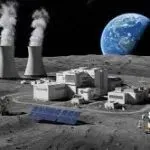“There’s a certain part of the moon that everyone knows is the best,” says NASA acting administrator Patrick Duffy, “we have ice there. We have sunlight there. We wanna get there first and claim that for America.”
On the moon, the sun sets for a fortnight, so solar won’t keep machines running.
The cost of building the 100 kilowatt plant is estimated at $3 billion. Last May, China and Russia announced they plan to build an automated nuclear power station on the Moon by 2035.
 In 2022, NASA issued three $5m contracts to companies to design a 40 kilowatt nuclear reactor for the moon. In 2023 the UK Space Agency gave Rolls-Royce a £2.9 million contract to demonstrate a lunar nuclear reactor.
In 2022, NASA issued three $5m contracts to companies to design a 40 kilowatt nuclear reactor for the moon. In 2023 the UK Space Agency gave Rolls-Royce a £2.9 million contract to demonstrate a lunar nuclear reactor.
Without an atmosphere or water to cool them, nuclear reactors on the moon need to radiate their excess heat directly into space requiring radiators measuring 100–200m².
Nuclear power on the moon would be used to power life-support systems, scientific instruments, and industrial activities, to supply electricity and heat needed for oxygen generation, water recycling, communications, computing, and maintaining safe temperatures for astronauts, enable activities like mining, manufacturing, construction, scientific experimentation and exploration and has the potential to enable more efficient propulsion for spacecraft which launch from the Moon,
